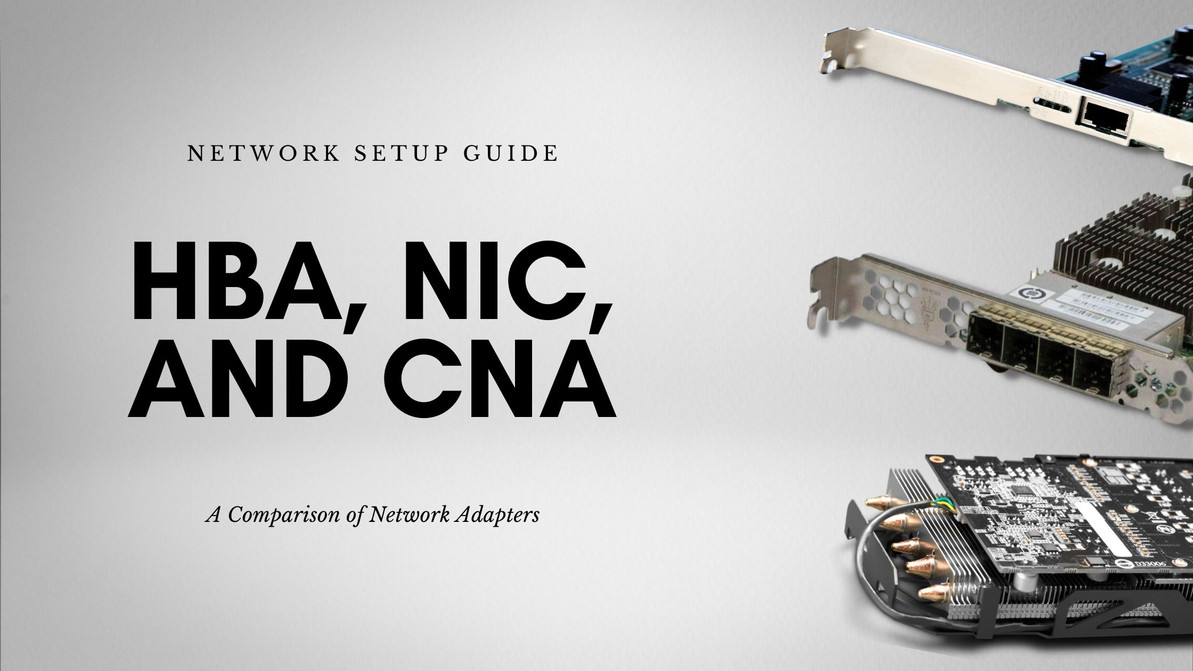Network Setup Guide: Comparison of HBA, NIC, and CNA
You need to make a lot of decisions when setting up a computer or a storage network for your company. You need to make sure that all your devices are compatible to ensure that everything will work out perfectly. These devices include your adapters.
There are three types of adapters commonly used in storage networks: Host Bus Adapter (HBA), Network Interface Card (NIC), and Converged Network Adapter (CNA). They all serve the same purpose which is connecting a host system to storage and network devices.
Different Types of Network Adapter
Here are the different types of network adapter:
Host Bus Adapter
HBA comes in the form of a circuit board or integrated circuit adapter. This type of adapter enables input/output processing. On top of that, it also makes a physical connection between the server or host I/O bus along with the other networking devices in a storage system.
An HBA card can significantly make storing and retrieving data easier on the host microprocessor.
HBA can be used in all kinds of interconnections, but it is most commonly utilized for protocols with Fibre Channel, iSCSI, and SAS connections.
Network Interface Card
NIC is more commonly known as LAN or Local Area Network card. It comes in the form of an expansion circuit board that allows devices and network servers to be connected through a network.
Converged Network Adapter
CNA, as the name suggests, can converge HBA functions with NIC. This hardware component can provide connectivity and data transfer between storage devices or servers. It can also be used to directly deliver Ethernet traffic from devices from the same network to the LAN.
Similarities and Differences of HBA, NIC, and CNA
HBA, NIC, and CNA cards all provide physical connection and data processing connection for devices. But they still have a unique feature that can be beneficial in different setups, settings, and applications.
HBA
This type of network adaptor is used to support different protocols.
Fibre Channel HBA
Fibre Channel HBA is the preferred adapter for FC SAN networks. This type of HBA is inserted in an HBA server then connected to a Fibre Channel switch through a fiber optic cable.
iSCSI HBA
iSCSI HBA is the preferred adapter for iSCSI-based IP SAN networks.
iSCSI HBA comes with either an RJ45 port or a fiber port that you can connect with a twisted pair cable or optical cable. This type of adapter allows your network to send SCSI commands to storage devices on remote servers through a TCP/IP network.
SAS HBA
SAS HBA is the preferred adapter for SCSI-enabled DAS networks.
As the name suggests, it provides the connection for SATA or SAS compatible devices using the SCSI command set.
NIC
NIC adapters are often iSCSI and NAS protocol-enabled which you can use for IP SAN and NAS networks.
There are two types of network interface cards-- the type with optical ports and the type with electrical ports. Much like HBA, you can use twisted-pair cables or fiber optic cables to connect. However, NIC is most often used for Ethernet while HBA is more commonly used for storage networks.
CNA
As mentioned previously, this type of adapter can combine the functionality of both HBA and NCI and support FC and Ethernet protocols using only a single interface port.
So how does that work? Ethernet is usually used for TCP/IP networks while Fibre Channel is used for storage networks. You can use a CNA card to transport Fibre Channel directly to an Ethernet port on an FCoE-enabled switch.
The CNA switch will then convert the FC traffic to the FC SAN and Ethernet traffic to the LAN.
Note:
If your network does not have CNAs, you need to use at least two adapters for your servers. One needs to be an FC HBA to enable you to connect the server to a storage network and a NIC card to connect the server to the LAN.
CNA cards are cost-effective in the sense that it reduces costs by needing much fewer adapter cards, cables, and switch ports. This type of network adapter also lessens the administrative and maintenance tasks because there is only one connection and one cable to manage. This reason is why it is preferred in data centers.
Bottomline
HBA, NIC, and CNA all have unique features which makes them great for different types of setup. You need to understand your network environment, budget, protocols, etc. before choosing the right adapter for your setup. Keep in mind that everything needs to be compatible to ensure that everything will work.
Recent Posts
-
Why It's Important to Purchase Genuine HPE Replacement Parts
When maintaining the integrity and performance of your Hewlett Packard Enterprise (HPE) systems, the …Jun 28th 2024 -
Mastering Modern Data: Cutting-Edge Storage Solutions in the AI Era
In the rapidly evolving digital era, Artificial Intelligence (AI) has become a cornerstone of innov …Jun 20th 2024 -
Product Comparison: HPE Q1J00A MSA 2050 vs. HPE Q1J10A D3710 vs. HPE 717870-001 MSA 2040
IntroductionIn today’s data-driven world, the demand for efficient, reliable, and scalable data stor …May 23rd 2024




